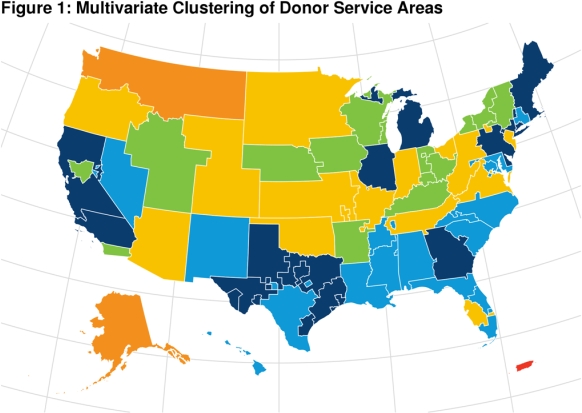Informed Clustering of Donor Service Areas for Better Benchmarking
United Network for Organ Sharing, Richmond, VA.
Meeting: 2018 American Transplant Congress
Abstract number: B320
Keywords: Donation, Methodology, Multivariate analysis, Procurement
Session Information
Session Name: Poster Session B: Non-Organ Specific: Economics, Public Policy, Allocation, Ethics
Session Type: Poster Session
Date: Sunday, June 3, 2018
Session Time: 6:00pm-7:00pm
 Presentation Time: 6:00pm-7:00pm
Presentation Time: 6:00pm-7:00pm
Location: Hall 4EF
The 58 Donor Service Areas (DSA) represent territories of varying geographic sizes, densities and populations. The intention of this project is to group DSA based on similar underlying characteristics to support Organ Procurement Organizations (OPO) and transplant centers in benchmarking themselves against others dealing with similar circumstances. Ad-hoc comparisons of DSA based on individual metrics provide naïve groupings. Incorporating multiple informative characteristics paint a more complete picture and can present likenesses only revealed by taking into account multiple factors.
We use a partitioning around medoids (PAM) approach to combine a priori defined characteristics of the DSA. Publicly available data were combined and aggregated for each DSA. Groups were constructed by taking one DSA as the median observation (medoid) per characteristics in Table 1 for each cluster, then adding each DSA to its closest medoid. If a DSA lowered the similarity within the cluster, the DSA are swapped to other clusters until the final groups are landed on. This highlights differences between groups as an aggregation of the key factors OPO use to compare themselves. Diagnostic measures informed the optimal number of discernible clusters.
Once group membership was determined, we examined the individual characteristics within- and between clusters to parse out those characteristics that were leading factors in distinctive group membership. Figure 1 is the result of our efforts to group DSA in a meaningful manner. Six clusters, two of which separate the PRLL and WALC DSA into their own group and the others containing 10-17 DSA, highlight inherent differences in DSA that do not conform to OPTN/UNOS regional boundaries. The results of this sophisticated grouping can form the foundation of an improved benchmarking framework that can be refined over time.
CITATION INFORMATION: Noreen S., Carrico R., Rosendale J. Informed Clustering of Donor Service Areas for Better Benchmarking Am J Transplant. 2017;17 (suppl 3).
To cite this abstract in AMA style:
Noreen S, Carrico R, Rosendale J. Informed Clustering of Donor Service Areas for Better Benchmarking [abstract]. https://atcmeetingabstracts.com/abstract/informed-clustering-of-donor-service-areas-for-better-benchmarking/. Accessed December 21, 2025.« Back to 2018 American Transplant Congress


